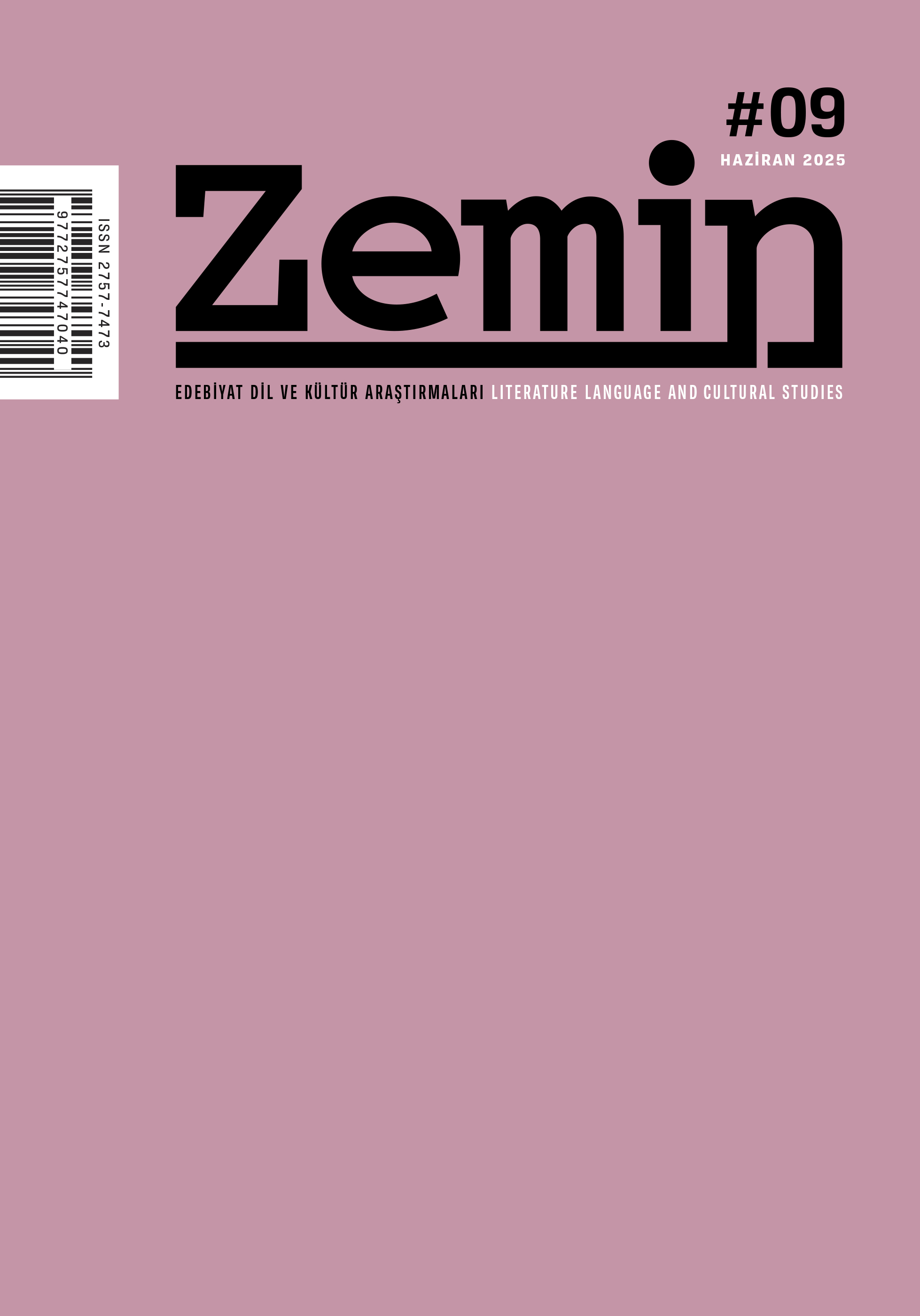The Possibilities of Ottoman Fiction: What Do We Know of Yaḥyā Çelebi, Evḥad Çelebi and Meymūne?
DOI:
https://doi.org/10.5281/zenodo.15657861Keywords:
Yaḥyā Çelebi Story, Evḥad Çelebi Story, space, transformation of a character, transformation of female characters, genderAbstract
This article explores the different versions and translations of a story, and examines how its main characters change and transform across each version and translation. To this end, it analyzes two different variants of the version known as the Evḥad Çelebi story and the Yaḥyā Çelebi story, and two of the latter’s French translations. The article first provides detailed summaries of the Yaḥyā and Evḥad Çelebi stories and then, for comparative purposes, illustrates how these narratives reflect the use of time and space in early modern Istanbul. It then discusses how the characters of Yaḥyā Çelebi and Evḥad Çelebi are portrayed in each version. Yaḥyā Çelebi often experiences feelings of shame and astonishment; he is an indecisive character who opens his inner self to the reader. In contrast, in Evḥad Çelebi, hesitation gives way to reliance on God. Evḥad Çelebi, who seeks refuge in God under all circumstances, has no difficulty making decisions and does not exhibit hesitation or shame. Variations in the representation of female characters across versions are also noteworthy. The nameless slave girl in the Evḥad Çelebi story becomes Meymūne in the Yaḥyā Çelebi story. One version of Evḥad Çelebi places the slave girl at the center of the story’s moral, while the French translation of Yaḥyā Çelebi reimagines Meymūne as a central character who takes action and can even commit murder if necessary. In parallel with these changes, the mother of Evḥad/Yaḥyā Çelebi also emerges with differing characteristics in versions. This close reading, focusing on character portrayal, concludes with a reference to Evḥad Çelebi as a historical figure who lived in 16th-century Istanbul. In conclusion, this study, which compares character representations in different versions and translations of the Yaḥyā and Evḥad Çelebi stories, highlights the manifestations of agency and gender relations that become visible through comparative reading.
References
Hikâyeler
Ḥikāyet-i Yaḥyā Çelebi bā şeyḫ Ebū’l-Ḫayyār der Üsküdar, Bibliothèque nationale de France. Département des manuscrits, Supplément turc 913, 31b.
“Ḥikāyet-i Cigerḫār-ı Hind ve ez macerā-yı Evḥad.” Ḥikāyāt. Ankara Adnan Ötüken İl Halk Kütüphanesi, 06 HK 3208, 87b-123a.
Relation memorable d’une avanture surprenante arrivée à un jeune homme de Constantinople et Scudar, Bibliothèque nationale de France. Département des manuscrits, Supplément turc 913.
M. le comte de Caylus, “Histoire de Jahia & Meimouné,” Les nouveaux contes orientaux, 1786. Elçin, Şükrü. “Evhad Çelebi Hikâyesi.” Halk Edebiyatı Araştırmaları. c. 2. Ankara: Akçağ Yayınları 1997.
Arşiv Kaynakları
“Vakf-ı merhûm el-Hâc Evhad,” İstanbul Kadı Sicilleri. Evkaf Muhasebesi 1 Numaralı Sicil (H. 1042-1044 / M. 1632-1635) cilt: 47, sayfa: 406 Hüküm no: 280 Orijinal metin no: [140b]
T.C. Cumhurbaşkanlığı Devlet Arşivleri Başkanlığı Osmanlı Arşivi A.DVNSMHM.d.58, hüküm no. 29/338: “Boğdan voyvodasına hüküm: İstanbul kasaplarından Hacı Evhad nam kasap koyun almak için birkaç adamını Boğdan’a gönderdiğinden narh üzere koyun almasına muavenet edilmesi.” [17.10.984].
T.C. Cumhurbaşkanlığı Devlet Arşivleri Başkanlığı Osmanlı Arşivi A.DVNSMHM.d.58, hüküm no. 58/71: “İstanbul kadısına hüküm: Yedikule kasaplarından Hacı Evhad ve İlyas nam kimseler gelip ikisinden maada kasap kalmadığını bildirdikleri arz olunmakla kasaplığı muktedir zengin adamlardan kasap tedarik etmesi.” [19.04.993].
İkincil Kaynaklar
Ağıldere, Suna Timur. “XVIII. Yüzyıl Avrupa’sında Yabancı Dil Olarak Türkçe Öğretiminin Önemi: Osmanlı İmparatorluğu’nda İstanbul Fransız Dil Oğlanları Okulu (1669-1873).” Turkish Studies International Periodical For the Languages, Literature and History of Turkish or Turkic 5, no. 3 (2010): 693-704.
Altok, Zeynep. “The 18th-Century ‘Istanbul Tale,’ Prose Tales and Beyond.” A Companion to Early Modern Istanbul, hazırlayanlar Çiğdem Kafesçioğlu ve Shirin Hamadeh, s. 581-604. Leiden, Boston: Brill, 2021.
Anetshofer, Helga. “Passion and Murder on the Bosphorus.” The Ottoman World: A Cultural History Reader, 1450-1700. Editör Hakan T. Karateke ve Helga Anetshofer. California: University of California Press, 2021.
Boch, Julie. “De la traduction à l’invention.” Féeries, 2 (2005): http://journals.openedition.org/feeries/103 (erişim 1 Eylül 2024).
Değirmenci, Tülün. “Bir Kitabı Kaç Kişi Okur? Osmanlı’da Okurlar ve Okuma Biçimleri Üzerine Bazı Gözlemler.” Tarih ve Toplum Yeni Yaklaşımlar, s. 13 (2011): 7-43.
Elçin, Şükrü. “Kitâbî, Mensur, Realist İstanbul Halk Hikâyeleri.” Halk Edebiyatı Araştırmaları. c. 2. Ankara: Akçağ, 1997.
Ersch, Johann Samuel ve Johann Gottfried Gruber. “Étienne Le Grand.” Allgemeine Encyclopädie der Wissenschaften und Künste, Erste Section A-G, Neunundsiebziger Theil. Leipzig: Brockhaus-Verlag, 1865.
Eyice, Semavi. “Hacı Evhad Camii.” TDVİA, XIV. https://islamansiklopedisi.org.tr/haci-evhad-camii (erişim 1 Eylül 2024).
Hitzel, Frédéric. “L’école des jeunes de langues d’Istanbul.” Langues et langages du commerce en Méditerranée et en Europe à l’époque moderne, hazırlayanlar Gilbert Buti, Michèle Janin-Thivos ve Olivier Raveux, 23-31. Aix-en-Provence: Presses universitaires de Provence, 2013.
İşli, Necdet. “Karacaahmet Mezarlığı.” TDVİA, XXIV. https://islamansiklopedisi.org.tr/karacaahmet-mezarligi (erişim 1 Ekim 2024).
Kavruk, Hasan. Eski Türk Edebiyatı’nda Mensûr Hikâyeler. İstanbul: MEB, 1998.
Kitâb-ı Mensûr: Realist İstanbul Hikâyeleri (Metinler). Hazırlayanlar Pakize Pervin Aytaç, Reyhan Gökben Saluk, Oğuz Demirbaş ve Gamze Bulgan. Ankara: Berikan Yayınevi, 2017.
Larousse, Pierre. “Pétis de la Croix,” Grand dictionnaire universel du XIXe siècle: français, historique, géographique, mythologique, bibliographique... vol. 12., 709-710. Paris: Administration du grand Dictionnaire universel, 1866-1890.
Necipoğlu, Gülru. The Age of Sinan: Architectural Culture in the Ottoman Empire. London: Reaktion, 2011.
Nutku, Özdemir. “Düğün.” TDVİA, X. https://islamansiklopedisi.org.tr/dugun (erişim 1 Nisan 2025).
Rothman, E. Natalie. The Dragoman Renaissance: Diplomatic Interpreters and the Routes of Orientalism. Ithaca: Cornell University Press, 2021.
Sezer-Aydınlı, Elif ve İrvin Cemil Schick, “Osmanlı İstanbul’unda Sese Dönüşen Kitaplar.” Zemin, s. 5 (2023): 50-111.
Soydan, Serdar. Masaldan Romana, Sözden Yazıya, İstanbul Hikâyeleri. İstanbul: Kapı, 2008.
Tanman, M. Baha. “Atik Vâlide Sultan Külliyesi.” TDVİA, IV, https://islamansiklopedisi.org.tr/atik-valide-sultan-kulliyesi (erişim 1 Ekim 2024).
Ünlü, Osman. “Gotik Bir Hikâye’de 18. Yüzyıl Üsküdar’ı.” Uluslararası 12. Üsküdar Sempozyumu (13-14-15 Ekim 2023): Tebliğ Özetleri, hazırlayan Coşkun Yılmaz, 109. İstanbul: Üsküdar Belediyesi, 2023.
Wishnitzer, Avner. As Night Falls Eighteenth-Century Ottoman Cities after Dark. Cambridge: Cambridge University Press, 2021.
Yıldırım, Nuran. “Miskinler Tekkesi.” TDVİA, XXX. https://islamansiklopedisi.org.tr/miskinler-tekkesi (erişim 1 Nisan 2025).
Downloads
Published
How to Cite
Issue
Section
License
Copyright (c) 2025 N. İpek Hüner

This work is licensed under a Creative Commons Attribution 4.0 International License.



